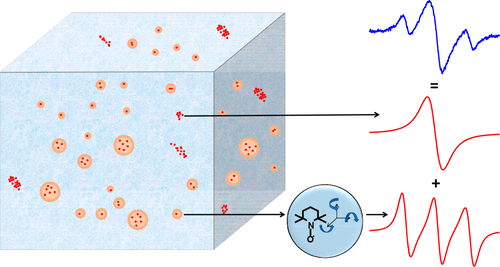当前位置:
X-MOL 学术
›
J. Phys. Chem. A
›
论文详情
Our official English website, www.x-mol.net, welcomes your feedback! (Note: you will need to create a separate account there.)
EPR Evidence of Liquid Water in Ice: An Intrinsic Property of Water or a Self-Confinement Effect?
The Journal of Physical Chemistry A ( IF 2.9 ) Pub Date : 2018-05-21 00:00:00 , DOI: 10.1021/acs.jpca.8b03605 Muthulakshmi Thangswamy 1 , Priya Maheshwari 1 , Dhanadeep Dutta 1 , Vinayak Rane 1 , Pradeep K. Pujari 1, 2
The Journal of Physical Chemistry A ( IF 2.9 ) Pub Date : 2018-05-21 00:00:00 , DOI: 10.1021/acs.jpca.8b03605 Muthulakshmi Thangswamy 1 , Priya Maheshwari 1 , Dhanadeep Dutta 1 , Vinayak Rane 1 , Pradeep K. Pujari 1, 2
Affiliation

|
Liquid water (LW) existence in pure ice below 273 K has been a controversial aspect primarily because of the lack of experimental evidence. Recently, electron paramagnetic resonance (EPR) has been used to study deeply supercooled water in a rapidly frozen polycrystalline ice. The same technique can also be used to probe the presence of LW in polycrystalline ice that has formed through a more conventional, slow cooling one. In this context, the present study aims to emphasize that in case of an external probe involving techniques such as EPR, the results are influenced by the binary phase (BP) diagram of the probe-water system, which also predicts the existence of LW domains in ice, up to the eutectic point. Here we report the results of our such EPR spin-probe studies on water, which demonstrate that smaller the concentration of the probe stronger is the EPR evidence of liquid domains in polycrystalline ice. We used computer simulations based on stochastic Liouville theory to analyze the lineshapes of the EPR spectra. We show that the presence of the spin probe modifies the BP diagram of water, at very low concentrations of the spin probe. The spin probe thus acts, not like a passive reporter of the behavior of the solvent and its environment, but as an active impurity to influence the solvent. We show that there exists a lower critical concentration, below which BP diagram needs to be modified, by incorporating the effect of confinement of the spin probe. With this approach, we demonstrate that the observed EPR evidence of LW domains in ice can be accounted for by the modified BP diagram of the probe–water system. The present work highlights the importance of taking cognizance of the possibility of spin probes affecting the host systems, when interpreting the EPR (or any other probe based spectroscopic) results of phase transitions of host, as its ignorance may lead to serious misinterpretations.
中文翻译:

冰中液态水的EPR证据:水的本性还是自我约束效应?
273 K以下纯冰中的液态水(LW)存在争议的方面,主要是因为缺乏实验证据。近来,电子顺磁共振(EPR)已用于研究快速冷冻的多晶冰中的深冷水。相同的技术也可以用来探测通过更常规,缓慢冷却的冰形成的多晶冰中LW的存在。在这种情况下,本研究旨在强调,在涉及诸如EPR之类的技术的外部探针的情况下,结果受到探针-水系统的二元相(BP)图的影响,该图还预测了LW域的存在在冰中,达到共晶点。在这里,我们报告了有关水的EPR旋转探针研究的结果,这表明探针的浓度越小越强,这是多晶冰中液域的EPR证据。我们使用基于随机Liouville理论的计算机模拟来分析EPR光谱的线形。我们表明,在非常低的旋转探针浓度下,旋转探针的存在会改变水的BP图。因此,自旋探针的作用不像是溶剂及其环境行为的被动报告者,而是作为影响溶剂的活性杂质。我们表明存在一个较低的临界浓度,在该浓度以下,需要通过结合自旋探针的限制效应来修改BP图。通过这种方法,我们证明了通过修改探针水系统的BP图可以解释在冰中LW域观察到的EPR证据。
更新日期:2018-05-21
中文翻译:

冰中液态水的EPR证据:水的本性还是自我约束效应?
273 K以下纯冰中的液态水(LW)存在争议的方面,主要是因为缺乏实验证据。近来,电子顺磁共振(EPR)已用于研究快速冷冻的多晶冰中的深冷水。相同的技术也可以用来探测通过更常规,缓慢冷却的冰形成的多晶冰中LW的存在。在这种情况下,本研究旨在强调,在涉及诸如EPR之类的技术的外部探针的情况下,结果受到探针-水系统的二元相(BP)图的影响,该图还预测了LW域的存在在冰中,达到共晶点。在这里,我们报告了有关水的EPR旋转探针研究的结果,这表明探针的浓度越小越强,这是多晶冰中液域的EPR证据。我们使用基于随机Liouville理论的计算机模拟来分析EPR光谱的线形。我们表明,在非常低的旋转探针浓度下,旋转探针的存在会改变水的BP图。因此,自旋探针的作用不像是溶剂及其环境行为的被动报告者,而是作为影响溶剂的活性杂质。我们表明存在一个较低的临界浓度,在该浓度以下,需要通过结合自旋探针的限制效应来修改BP图。通过这种方法,我们证明了通过修改探针水系统的BP图可以解释在冰中LW域观察到的EPR证据。



























 京公网安备 11010802027423号
京公网安备 11010802027423号